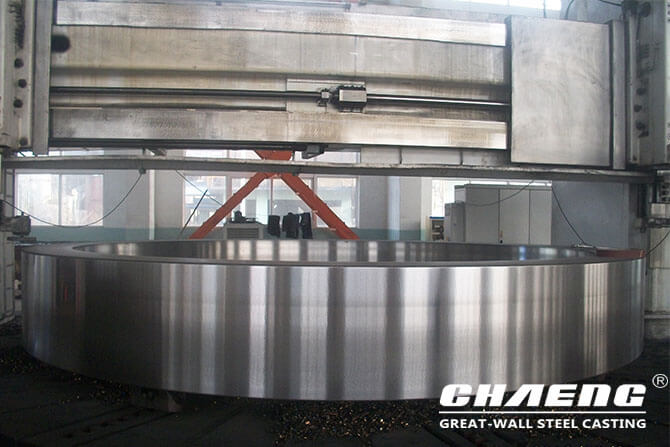Functions and main damages of kiln tyre
04 May 2018 UTC+8Views:
The role of the kiln tyre (also known as the rolling ring) is to transfer the weight of the cylinder (including refractory bricks, internal devices and materials, etc.) to the support roller, and to enable the cylinder to rotate smoothly on the support roller, so the kiln tyre must have sufficient strength and durability. At the same time, the rotary kiln tyre is a part that reinforces the radial rigidity of the cylinder, so it also should have sufficient rigidity. Due to the effect of heat, attention should also be paid in the design to reducing the temperature stress in the tyre.

Common types of wkiln tyre damage are the following:
1. Flare flaking, pitting, cracking, crushing, etc. occur on the outer surface of the kiln tyre. On the contact surface of the kiln tyre and the rotary kiln support roller, a large contact stress is generated due to the huge load. Therefore, when it operates, surface fatigue damage occurs due to repeated contact stress. Generally, in the old kilns that have been in operation for two or three decades, it is common to have honeycombed pits on the tyre.
2. Premature wear in use. Due to the skew of the rotary kiln support roller or the basic subsidence of the pivot points of the rotary kiln, the axes of the rotary kiln tyre and the support roller are not parallel and the local contact stress increases, so that the cylindrical tyre is worn to saddle shape, drum shape, cone shape, etc. During designing, if the material and hardness of the kiln tyre and the support roller are not properly matched, premature wear may also be caused.
3. Cracks in the radial section of the kiln tyre. Due to the huge load, bending stress is generated on the radial section of kiln tyre. At the same time, the temperature difference between the inner and outer wall of the rotary kiln tyre also generates temperature stress on the radial section (if the stress is generated between the tyre and the cylinder in the hot state, the tension on the radial section of the tyre will also increase) . In addition, if the kiln tyre annealing is incomplete, casting stress will occur in it. The superposition of these three will lead to cracks and even fractures in the radial section of the kiln tyre.
4. Rotary kiln tyre has insufficient rigidity. The stiffness of the tyre has a great influence on the radial stiffness of the cylinder and is a prerequisite for prolonging the life of the refractory bricks in the rotary kiln.
The above-mentioned damage type of the kiln tyre shows that when designing the tyre, the bending stress, temperature stress, contact stress, and rigidity of the cross section must be calculated and checked.
Advantages of kiln tyre made by CHAENG
1. High strength, good durability
CHAENG uses ZG45 and ZG42CrMO material, which can guarantee the strength and toughness of kiln tyre, so as to play a better supporting role.
2. Use advanced dual-medium quenching process
CHAENG uses CAE software to simulate the casting process and adopts advanced two-medium quenching process to process uniformly every part of kiln tyre, so that CHANEG kiln tyre has high hardness and high toughness and good wear resistance, can adapt to a variety of harsh working environment.
3. CHAENG kiln tyre has simple structure which is easy for routine maintenance.
4. CHAENG can produce a variety of rotary kiln tyre according to the customer's drawings.
The optimized technology and excellent quality can ensure that rotary kiln produced by CHAENG matches well with the original rotary kiln equipment.

Welcom to consult us when you need a new kiln tyre!
CHAENG - Xinxiang Great Wall Steel Casting Co., Ltd
Email: casting@chaeng.co
Tel: 86-371-55019878
Skype: greatwall1958





